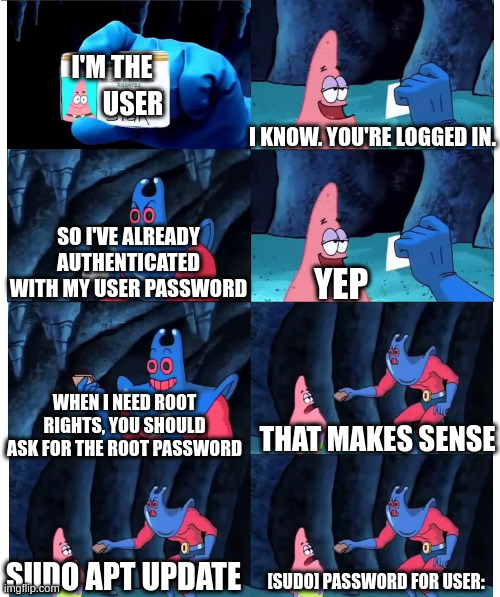this post was submitted on 11 Nov 2024
-34 points (22.6% liked)
Linuxsucks
184 readers
27 users here now
Rules:
- FOSS advocates and Linux evangelists aren't welcome. -We ask that you block us.
- Moderation is heavy handed. Try to stay on topic.
- No Complaining Mute the sub if users, content, or rules bother you
founded 1 month ago
MODERATORS
you are viewing a single comment's thread
view the rest of the comments
view the rest of the comments

Yea, I don't think you understand what you're saying. Security is not a binary thing - it's layered. And your user is not, in fact, authorised to do pretty much anything outside your homedir.
If the user is in the sudoers file, they are authorized to do the things configured there.
Which is obvious when they can do the thing after entering their own password.
But since they already entered the same password at login, and are still logged in, there's no point in entering the same password one more time.
If that's your idea for security, you might as well pop up another password prompt every half hour to check that the same person is still on the PC.
The argument "a password prompt tells the user to stop and think" is wrong. That's not what a password prompt's purpose is.
For that, you can pop up a confirmation dialog, or even a text box where they have to type in "yes".
Using a password for anything other than proving the correct user is at the keyboard makes it less secure.
This is why Active Directory and Kerberos are so great. You log in once in the morning, and that's it.
And since you only have to type in your password once before work, it can be really secure and long.
Also, the chance of someone standing behind you while you type it is reduced.
Correct. But the thing configured there is "to act on behalf of root for these items", not the "things" themselves.
It is not you executing stuff with
sudo.file1is owned by you, butfile2is owned byroot.There is a point. See above.
That's not an argument I've made, nor make.
Both of which are much easier to defeat than a pop up confirmation dialog with a text box for your password.
No it doesn't - you seem to be making things up to justify your lack of understanding. Authentication is not the same as authorisation, nor should it be treated the same way.
When you type in your password on a login prompt - you authenticate who you are.
When you type in your password on a sudo prompt - you authorise a command to be carried out on behalf of
root.I'm not sure you realise how little you do on a windows machine. Good luck installing system software or altering system files on an AD managed Windows machine without authorisation. Which is what your meme(?) is implying.
There is no justification here, just a manufactured statement.
See above.